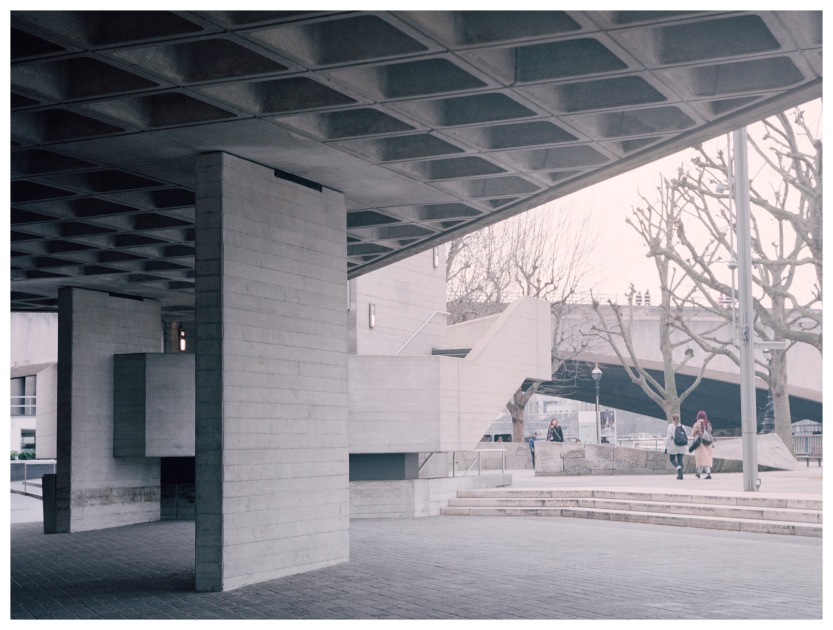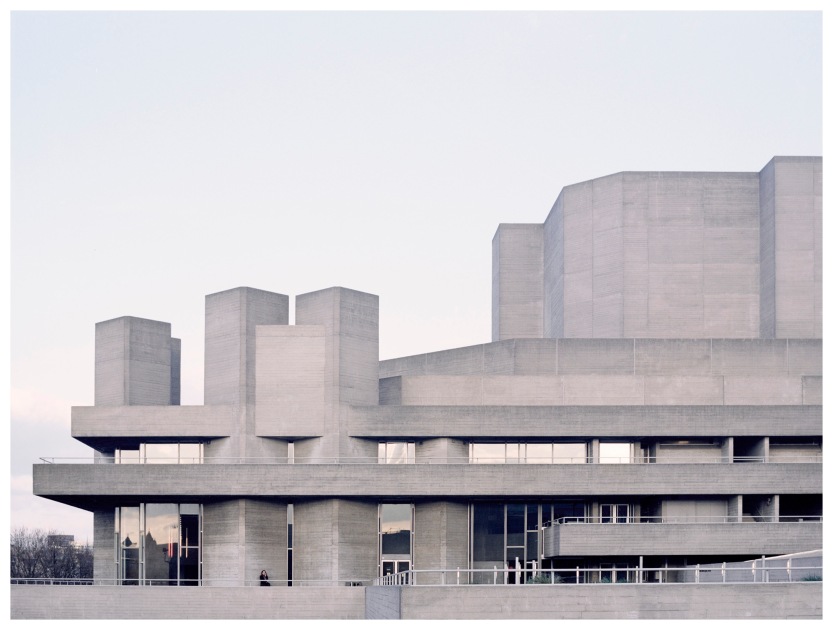
Denys Lasdun’s National Theatre is a sensitive and delicate essay in place-making and landscape, painted in beautifully vicious concrete.
Building Study 002: The National Theatre, London, 1976. Denys Lasdun.


All photographs are courtesy of, and copyright, Rory Gardiner.
When Denys Lasdun attended an interview (alone) to try to win the job he said “the essence of designing a theatre is a spiritual one”, then apparently admitted he knew nothing about designing theatres. Laurence Olivier however remained suitably impressed: “Oh, my dear, we all fell for that. We knew we’d got by far the best man”1.
He was by far the best man. Lasdun’s “architecture of urban landscape”2 was the perfect approach to the unique opportunity created by this project – to build an open manifestation of democratic access to the arts, on a prominent site in London. The final scheme would become a scaled down version of the initial brief which included an opera house on a nearby site. Nonetheless, the project has become a landmark in so many respects; urban, cultural, and architectural – a beacon of courageous and confident artistic expression.
The National Theatre is “one of the seminal works of British Modernism”3. Like many great works of architecture, it is defined by provocative aesthetics and bold complexity – but the fundamental quality here is urban sensitivity (which may not be immediately apparent) which deftly places the building in the city. While the footprint of the building is considerable, its scale is deliberately broken down. The horizontal ‘strata’ blur the edge of the building, breaking down its mass and creating ambiguity as to where the building ends and the city starts.


The two primary vertical elements (fly towers over the main auditoria) create a sense of landmark, placing the building definitively within the fabric of the city. These, along with lesser vertical pieces of circulation etc. are all bound together by those ubiquitous horizontal bands. Lasdun called these ‘strata’, “public spaces, public domains… an extension of the city”4. These are the places Lasdun anticipated would create opportunities for social interaction, and that’s exactly what happens. The platforms link in to the building and connect the South Bank and Waterloo Bridge, and the people who move over them become characters in an urban play.
“In the National Theatre everyone becomes an actor and all the building is a stage”.5
The specification of the pale concrete was selected to sit harmoniously with the stone of Waterloo Bridge and Somerset House on the opposite bank, and also to St Paul’s cathedral – and set-piece moments in the external terraces offer places to observe each of those landmarks. Given the challenging formal expression of the building, the use of concrete could be considered audacious, but it actually does create a synergy with the material palette of those important adjacent buildings. This shows Lasdun’s confidence in the architecture, but also the sympathetic and well-informed manner of his approach to the building’s context.
“The result is a monument that is also a non-monument – a building that splices together hieratic formality with a deliberate openness and availability”.6
There’s a legible progression from the public realm in front of the building to the main foyer, which is a rich and dramatic space. From the generous external spaces there’s a sense of compression at the entrance, before the foyer rushes out, both horizontally and vertically. The arrangement of structural elements suggests informal sub-spaces within the greater space. There are long views to internal and external spaces, giving glimpses everywhere of the urban ‘actors’.

Themes develop (formally and materially) across the space, all drenched in contradiction – heavy concrete elements which hover effortlessly; contrary overlapping geometries; spaces enclosed but giving long views out; darkness against light. All of this creates a rich tension, adding constantly to those theatrical spatial rhythms.
Curtis associates this with Lasdun’s interest in music, comparing the building to “a symphony [where] themes develop, expand, recede, repeat, and invert, but always within the binding order of a larger expressive structure”7. While much of the foyer sits alongside full height windows looking to the outside, there are other parts which feel grotto-like. The horizontal board-marking on the stunning slender concrete piers seem to have formed in sedimentary layers – enhancing the abstract, geological feel of the space.





The climax of the spatial progression through the building is the Olivier Theatre, the main auditorium. It sits at 45deg to the primary mass of the building. Appropriately, it is a vast, rich, dramatic room – and is formed in tactile insitu concrete – maintaining the sense of material harmony that binds the entire composition together.
Having passed the building in a taxi while it was still under construction, the poet and writer John Betjeman was compelled to write to Lasdun to describe how he had “gasped with delight” on seeing the building… and that the “theatre looks so good from so many angles… it has that inevitable and finished look that great work does”8.


There is a delightful duality in the National Theatre; between an urban mass and architectural expression that is muscular and monumental in scale; set alongside the intimate, humane spaces that form a truly wonderful public realm.
That paradox gets to the core of much of Lasdun’s work, and particularly defines the National Theatre. The vocabulary of ‘brutal’ massing exists in almost unexpected synergy with a sensitive commitment to people – and place. The building establishes a careful dialogue with the city (at both a human and an urban scale) and arranges a sequence of delicate moments; places where it’s possible to stop and absorb the situation – a theatrical essay in urban landscaping and place-making that is brilliantly suited to the building’s function.
The ill-informed ‘nuclear power station’ label, applied to the National Theatre by an ill-informed critic misses that point – that whilst the language is provocative and challenging, the message is profoundly humane.

Notes:
1 The Architects’ Journal, 08.05.15, pg 36.
2 Curtis, ‘Modern Architecture Since 1900’, pg 540.
3 The Architects’ Journal, 08.05.15, pg 43.
4 Denys Lasdun, quoted by Curtis, in ‘Denys Lasdun’, pg 108.
5 Curtis, ‘Denys Lasdun’, pg 113.
6 Curtis, ‘Denys Lasdun’, pg 136.
7 Curtis, ‘Denys Lasdun’, pg 136.
8 Curtis, ‘Denys Lasdun’, pg 152
Author’s Note: I’d like to thank Rory Gardiner, who kindly provided the photographs for this piece. Rory’s site is full of beautiful, sensitive images of wonderful buildings, http://www.rory-gardiner.com
Your ability to make others see the beauty in architecture is amazing!
Alos, wanted to let you know I nominated you for the Liebster Award: https://milesofpagesblog.wordpress.com/2017/08/04/liebster-award/
LikeLiked by 1 person
Thank you!
LikeLiked by 1 person
You captured all the architecture so beautiful!
LikeLike